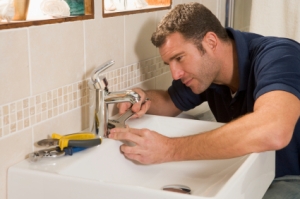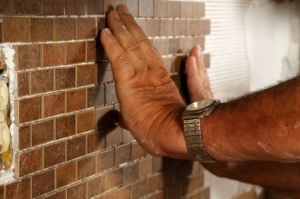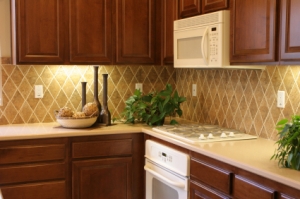In addition to being aggravating in general, leaking faucets make water bills go through the roof. With that in mind, it’s smart to take care of the problem right away. There are many places where a faucet can leak, and a leak at the handle can be especially perplexing. Despite turning the handle as far as possible, a small, steady trickle of water may drip out into the sink. When the faucet is on, the leak may turn into a small stream that gets onto counters and causes a mess. The good news is that repairing a faucet that’s leaking at its handle is fairly simple. Just follow the directions below.
What You’ll Need
Until you take apart the handle, you won’t be able to tell what is specifically causing the leak. Fortunately, it’s probably just one of two possible things: A damaged handle cartridge or a corroded, cracked O-ring. Neither part is especially expensive, so you might as well replace them both while you’re at it. The local big-box home improvement store is sure to have both pieces, and you can probably find them at smaller hardware stores as well.
In addition to buying O-rings and a handle cartridge, you will need the following tools:
- Wire brush
- Mini screwdriver
- Allen wrench set
- Flathead screwdriver
- Sharp knife
- Wrench
- Non-toxic, heatproof plumber’s grease
- Calcium solvent

1) Turn Off the Water
Any time you work on a sink, the first step is to turn off the water. The last thing you need is to be sprayed in the face after pulling off the handle.
- Look beneath the sink. There should be two valves located at the back or side of the cabinet.
- Turn each valve all the way to the left. You may have to use a wrench. Don’t use excessive force because it could damage the valve and force you to run out and buy a new one.
- Close or cover the drain to keep screws and other hardware from dropping in and getting lost.
2) Remove the Handle
The only way to repair a leaking faucet handle is by removing it. Follow these steps to do so.
- Take a minute to examine the handle and faucet. The specific steps that you’ll need to take will depend on how it is designed.
- If you have an older faucet, you should be able to simply twist off the handle or handles. Turn the handle as you would when turning it on. When it reaches what seems to be the farthest point, apply a little extra pressure and keep turning. It should push past that point. From there, keep turning it until it twists off completely.
- To remove the handle on a newer faucet, look for the brand logo near its base. You should be able to pry it off with a flathead screwdriver. Once it’s removed, you will see a tiny hole. Insert the Allen wrench or mini screwdriver into the hole and twist it to the left. At this point, you should be able to remove the handle.
3) Fix the Handle
Now that you’ve removed the handle, you can really get down to business. Keep in mind that the following steps are simply a guide. The assembly of your faucet and handle may differ slightly. You might want to snap photos as you work so that you can put it all together again easily.
- If you have a newer faucet, you will see a shroud. Twist it to the left to remove it.
- You should now see a small adapter that’s secured by a screw. Using a wrench to hold the assembly in place, remove the screw. The adapter should pull off with ease.
- Remove the small plastic cover that you’ll see after removing the adapter.
- There will be another, larger plastic cover. To remove it, twist it to the left with a wrench.
- To remove the small clip, just pry it off with a flathead screwdriver.
- Using the wrench, pull up on the stem of the faucet. This will allow you to access the spacer, which you should remove. At this point, you should be able to pull the stem off all the way.
- Use a wire brush and calcium solvent to remove any buildup. If it’s not removed, it could keep causing problems in the future.
- Remove the O-ring or O-rings and replace them with the new ones.
- Put in the new handle cartridge.
4) Rebuild the Faucet Handle
To rebuild the faucet handle, just follow the same steps you did before but do them in reverse. This is where the photos you took earlier will come in handy. Take your time while rebuilding the handle. Securely fasten all of the hardware and wipe everything down to ensure that it is dry and free of debris.
5) Test the Faucet
After everything is in place, turn the water back on by turning the valves beneath the sink. Look closely for signs of a leak. Turn the handle or handles and check to see if water leaks from them when the water is on. If not, you are good to go.
Tags: faucet, fix, leaking faucet, repair



